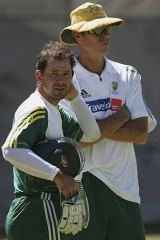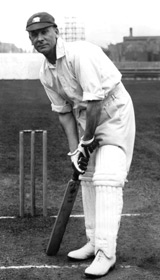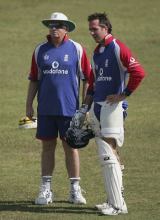Aye, aye, coach - the rise and rise of the backroom boys
|
|

|
The formative trends in cricket, as in the world in general, are often understood only in retrospect. So it is with coaching. Twenty years ago, after an unsuccessful tour of New Zealand, the Australian Cricket Board appointed Bob Simpson as the first full-time coach of the national team. Today, the role in every country is crucial, controversial and rather precarious: eight of the ten Test nations have changed their coach in the past three years, some several times.
However, the first cause for wonder is not the 20 years in which coaches have been a phenomenon, but the preceding century in which they were not. Every other sport knelt at the altar of the coach, manager or guru; in cricket, despite a technical rigour and complexity that begat so many instructional books, the captain remained all-powerful. The game, as it were, was learned without formally being taught.
There have been figures called coaches in first-class cricket for many years, but they tended in olden times to be sinecured former players responsible for duties like managing net practice or taking care of the team's equipment. W. T. Grayburn was "coach" at Surrey when Jack Hobbs joined a century ago, for example, but Hobbs learned nothing from him. "As a matter of fact, I have never had one hour's coaching from anybody in my life," he recalled, "and the reason why I emphasise this point here is that I am a natural batsman, entirely self-taught."
When the venerable Charles Lawrence retired from the Melbourne Cricket Club in 1900, he was not replaced. "In the Melbourne nets alone there are on a brilliant summer evening sometimes a hundred players hard at it," noted the former Australian captain Tom Horan on the eve of the First World War. "Yet never once since Charlie Lawrence left have I seen an attempt made to coach a young bowler at the nets."
Australians often considered coaching a restraint on the flowering of innate ability. "In Australia, boys learn by watching each other and any grown-up cricketers who they see," wrote Fred Spofforth. "The result is individuality, and their natural ability is not dwarfed by other people's ideas." A hundred years ago, Dr Leslie Poidevin saw cricket as bred in the Australian bone: "There's something marvellous about a young Australian's devotion to and aptitude for the game. He gets no `coaching'. He merely takes a bat and it seems to be `in him' to know what to do with it."
Part of the legend attached to giants of the Australian game such as Don Bradman and Bill O'Reilly was their flouting of orthodoxies. O'Reilly recalled being the recipient of coaching advice at the Sydney Cricket Ground nets within the hearing of Charlie "The Terror" Turner; Turner sidled up and told him to take no notice, confiding that he had profitably ignored coaches' advice all his career. In 1929, when the New South Wales Cricket Association mooted employing a professional coach, ten former Test players put their names to a letter objecting "that the natural Australian freedom of style might be sacrificed by the introduction of orthodox teachings".
There was certainly no question of a Test team having a formal, full-time coach. If players had something to learn, they did so from each other. When Neil Harvey struggled to come to terms with English conditions on his first tour in 1948, he sought advice from Bradman via his room-mate Sam Loxton, and received back the oracular counsel: "Hit the ball on the ground and you can't be caught."
The situation changed, almost by chance, in the late 1970s when Ken Barrington began to carve out a role separate from that of the ambassadorial tour manager, a post which was considered as much an honour as a job. Barrington had two turns as manager, struggling with the political fallout from the Packer breakaway, but excelling so much as an adviser and paterfamilias that Lord's agreed to take him to Australia as an assistant in 1978-79. Two years later, he was initially excluded and then reinstated on the players' insistence, for the tour of the West Indies, on which he suddenly died.
Had he lived, Barrington might have beaten Simpson into office. He was there, however, because he was Barrington rather than because he was coach, and there was no question of him being involved for home games, nor was there thought to be any immediate need to replace him. Australia's decision to name a full-time coach in 1986 met with considerable scepticism. The first man offered the job, Ian Chappell, declined because he doubted the role was necessary; the second, Simpson, said he regarded it as finite, and foresaw making himself redundant; when England appointed Micky Stewart to a similar role later the same year, he was designated not "coach" but "team manager".
The impetus for the appointments of Simpson and Stewart was simple: failure, and resultant dislocation in leadership. Australia had had four captains in five years, England six, and the latest appointments, Allan Border and Mike Gatting, were bearing their burdens uneasily. Simpson ascribed the need for his job to the "diminishing role of the Australian captain and the almost total destruction of peer influence within Australian cricket" as a result of the dislocation that came in the wake of Kerry Packer's World Series Cricket.
The creation of the roles also reflected the trend to specialisation in numerous occupations: how could a captain be responsible for technical supervision and physical conditioning as well as pre-match strategy and onfield tactics? Cricket was not pioneering anything, so much as catching up with other sports. In the United States, coaches like Knute Rockne, Vince Lombardi, Tom Landry (all American football), Bobby Knight (basketball), Yogi Berra (baseball), and Nick Bollettieri (tennis) have long been as famous as any athletes. And in the 1970s English soccer managers had emerged from the shadows. Men like Brian Clough, Tommy Docherty and Malcolm Allison - with far more freedom than their charges to speak their minds - had started to eclipse the players in the public consciousness.
|
|

|
The other factor in the rise of the coach, generally ignored, was television. Instant, then slow-motion, video replays made it possible to study technique up close over and over again. Brian Booth, who captained Australia in the 1960s, recalled that in his entire career he saw himself bat for only one delivery: by chance, he once saw himself being bowled on a newsreel. Ricky Ponting, the present incumbent, can now watch every ball of his international career as often as he wants, on TV or his laptop. It is one thing to tell a player he is doing the wrong thing; it is quite another to show him. The role of replays has expanded from the analytical to the motivational, for Test cricketers today routinely prepare for playing by watching footage of their earlier successes: a means of reminding themselves of what they are capable. Simpson was a coach of a conservative disposition, but conservatism in his time was a form of revolution. He stressed basics like fielding and running between wickets, and preached the gospel of hard work to a team, at first, averse to it: "In many cases, the work ethic was non-existent... What was worse, they did not seem to want to match up. Instead, they treated the whole training exercise as a bit of a joke, in order, I believe, to disguise the fact that they couldn't hack it." When Australia won the 1987 World Cup as rank outsiders, their strength was perceived as a dedication to detail, and a vindication of the idea of an off-field task master.
Stewart, a player of less ability than Simpson but similar discipline and determination, brought an NCO's gruffness to his role. Some captains were more at home with his religious devotion to physical preparedness than others. David Gower, a sceptic, deplored Stewart's "soccer-manager style of bullshit". Graham Gooch, a true believer, recalled that they "debated and discussed things endlessly and never seriously fell out about anything". Both Simpson and Stewart also constituted a buffer between their captains and an increasingly demanding media. If Australia and England had had stronger, more confident, captains in this period, the coach would not have risen to power so conspicuously. As it was, from the early 1990s, all countries came into line by appointing officers, titled either "coach", "team manager" or "cricket manager", at least for tours.
The thought put into each appointment varied - Mike Procter was chosen four days before South Africa commenced their return to international cricket at the end of 1991 - and likewise the perceived difference to team performance. But the appointments occasioned so little fuss that it must be assumed Test cricket had by then developed a coach-shaped hole. International cricket was ready for the national coach; whether the national coach was quite ready for international cricket was another matter.
Cricket is a game that measures almost everything. But how was the coach to measure the value he was adding to his team by anything other than the banal ledger of wins and losses, or the subjective gauge of observation and anecdote? After all, when Yogi Berra was once asked what made a great baseball coach, he replied simply: "A great ball team". The 1990s became, accordingly, a period of considerable experimentation. The experiences of Kapil Dev with India and Vivian Richards with West Indies suggested that getting the right coach was not as easy as appointing a great player, but nor did astute captains like England's Keith Fletcher and New Zealand's Geoff Howarth make off-field masterminds. The reign of Ray Illingworth did little for the cause of a single supremo with selection as well as training responsibilities; in fact, apprehension about the consolidation of too much power in one individual saw Simpson lose his role in selection. Meanwhile, the ambit of other coaches, particularly in Pakistan, was too restricted for them to make much difference.
Two men in particular were perceived to have moved the game onwards. Bob Woolmer ran South Africa's team innovatively with help from sports scientist Tim Noakes from the University of Cape Town. And eventually Australia turned to John Buchanan, who has a degree in "human movements'' from the University of Queensland and a first-class batting average of 12. Not all Woolmer's innovations, however, occasioned admiration, particularly the earpiece with which he fitted captain Hansie Cronje at the 1999 World Cup; the later revelation that his players consorted with match-fixers without telling him also suggested communication between them was less than constant. And Buchanan, with his affinity for management-consultancy jargon, has never convinced, for instance, Ian Chappell: "If I had a son, the last bloke in the world I would take him to for cricket coaching would be John Buchanan."
But the individuals most closely identified with significant improvement have been three hard-working sweats who made the most of sometimes limited abilities in their playing days, and who are likewise capable as coaches of wringing extra from talent at their disposal: Dav Whatmore in Sri Lanka, John Wright in India and Duncan Fletcher in England. All came from outside their respective cricket systems. All won reputations for meticulous preparation and close relationships with their captains.
|
|

|
The deadpan Fletcher, a former skipper of Zimbabwe whose coaching spurs were won at unfashionable Western Province and Glamorgan, has been the most surprising. His former captain Nasser Hussain has admitted nothing but surprises in the early stages of their partnership: "I thought I would be starting off as the senior partner with the perceived upper hand in our relationship because I was the one who had played a lot of Test cricket... I thought he would be coming to me saying `What's he like?', `What's that one like?' How wrong could I have been! I soon realised that Duncan knew everything about everyone!"
Trends in coaching have been governed by cycles of success, with the perception that any success is somehow a vindication of the coaching model. For the last few years, with their team all-powerful, Australian coaches have been the vogue. Indeed, by 2005, Australia had become the only Test-playing country never to appoint a foreigner. During the 2005 Ashes series, England were perceived to have gained an advantage from the work of Fletcher's Australian bowling coach, Troy Cooley, plus the home-grown batting coach Matthew Maynard. "We can learn from England," said Ricky Ponting on returning home. `They were well managed, well skilled and had planned well. It's a pity that we didn't have any expert coaches to help our guys out." Look out for Australia, and other countries, taking care to avoid that pity in future. They started by luring back Cooley.
Coaching at cricket's top level may also become more individualised, with the rise of personal coaches for the provision of one-on-one advice. "Life coaching", a combination of psychotherapy and personal management consultancy for the social group known as "the worried well", has swept the US in the last five years. And 200 of the top 500 American companies use "executive coaches"; according to one CEO, Bob Nardelli of Home Depot, executives without coaches "will never reach their maximum capabilities". Back on the cricket field, the Australian batsman Michael Clarke arrived on the international scene with his own coach-cum-manager, Neil D'Costa, a former Sydney Grade coach. D'Costa had been Clarke's mentor since he was seven, with a broad brief to prepare him not only for sport but life: when Clarke was 20, for instance, D'Costa sent him to live with the Australian soccer player Aytek Genc to learn about the reality of being a professional sportsman. When Clarke learned he would make his Test debut at Bangalore in October 2004, he flew D'Costa in to share the moment. The obvious question, however, is what might happen to a player given conflicting advice by national and personal coaches.
What is clear already is that coaches in cricket meet similar fates to those in other sports when they are perceived to be failing: Bangladesh have had no fewer than five coaches in the last ten years. Because results are expected fast, coaches are striving to move faster. The honeymoon between the new Indian coach Greg Chappell and his captain Sourav Ganguly, for instance, ended as soon as it began, on their first tour in September last year. And while coaches have so far circulated freely - Woolmer, Whatmore and another Australian, Geoff Marsh, all coaching two countries - how long before sovereign interests intrude? After Woolmer went from Warwickshire to South Africa, he received a Christmas card calling him a traitor to England and advising that he would "rot in hell".
What would happen if one country became so set on another's coach as to poach him on the eve of a Test series between them? Australia's strenuous and successful efforts to recapture Cooley may be a harbinger. The old saying is that not much new happens in cricket, but the rise of the coach is taking us into unknown territory.

